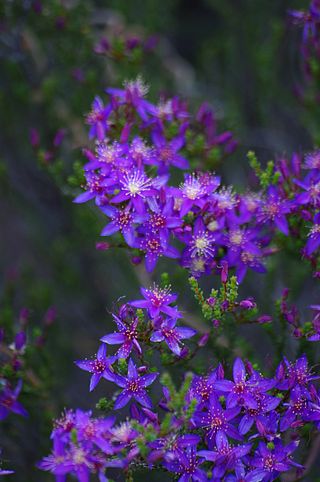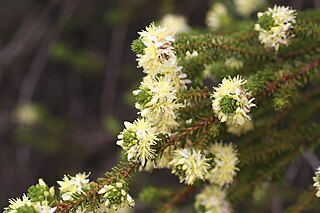
Calytrix depressa is a species of flowering plant in the myrtle family Myrtaceae and is endemic to the south-west of Western Australia. It is a glabrous shrub with linear to lance-shaped leaves and mauve to violet or yellow flowers with 35 to 75 stamens in several rows.

Calytrix leschenaultii is a species of flowering plant in the myrtle family Myrtaceae and is endemic to the Southwest Australia of Western Australia. It is a mostly glabrous shrub with egg-shaped, elliptic, lance-shaped or linear leaves and purple, mauve, violet or pink flowers with a white or yellow base, and 6 to 40 white or yellowish stamens.
Calytrix birdii is a species of flowering plant in the myrtle family Myrtaceae and is endemic to inland areas of Western Australia. It is a shrub with egg-shaped to more or less round leaves and clusters of purple flowers with 45 to 55 reddish-purple stamens in several rows.

Calytrix brevifolia is a species of flowering plant in the myrtle family Myrtaceae and is endemic to the west of Western Australia. It is a glabrous shrub with egg-shaped, linear, elliptic or more or less round leaves and clusters of pink to magenta flowers with about 40 to 90 yellow stamens in 4 rows.

Calytrix creswellii is a species of flowering plant in the myrtle family Myrtaceae and is endemic to inland areas of Western Australia. It is a spreading, glabrous shrub usually with egg-shaped leaves with the narrower end towards the base, and clusters of white flowers with about 40 to 55 white or yellow stamens in several rows.

Calytrix drummondii is a species of flowering plant in the myrtle family Myrtaceae and is endemic to the Geraldton Sandplains bioregion of Western Australia. It is a glabrous shrub with linear leaves, and yellow flowers with about 55 to 85 yellow stamens in several rows.
Calytrix eneabbensis is a species of flowering plant in the myrtle family Myrtaceae and is endemic to the south-west of Western Australia. It is a glabrous shrub with lance-shaped leaves and purple and yellowish flowers with 40 to 60 stamens in several rows.

Calytrix formosa is a species of flowering plant in the myrtle family Myrtaceae and is endemic to the west of Western Australia. It is a glabrous shrub with erect, elliptic, broadly elliptic or oblong leaves, and pink flowers with about 90 to 105 stamens in multiple rows.
Calytrix gypsophila, commonly known as gypsum fringle-myrtle, is a species of flowering plant in the myrtle family Myrtaceae and is endemic to southern continental Australia. It is a glabrous shrub with oblong, linear or lance-shaped leaves with the narrower end towards the base, and white flowers with 25 to 40 stamens in a single row.
Calytrix paucicostata is a species of flowering plant in the myrtle family Myrtaceae and is endemic to a restricted area in the west of Western Australia. It is a shrub with linear leaves and bright to rich pink flowers with about 75 to 88 stamens in several rows.
Calytrix platycheiridia is a species of flowering plant in the myrtle family Myrtaceae and is endemic to a restricted area in the south-west of Western Australia. It is a shrub with egg-shaped leaves and cream-coloured flowers with about 35 to 50 yellow stamens in several rows.
Calytrix harvestiana is a species of flowering plant in the myrtle family Myrtaceae and is endemic to the west of Western Australia. It is a glabrous shrub with linear, elliptic or egg-shaped leaves and purplish mauve to purple or violet flowers with about 60 to 70 pale yellow stamens in multiple rows.
Calytrix merralliana is a species of flowering plant in the myrtle family Myrtaceae and is endemic to inland areas of Western Australia. It is a glabrous shrub with linear to elliptic leaves and violet flowers with about 45 to 55 yellow stamens in several rows.

Calytrix oldfieldii is a species of flowering plant in the myrtle family Myrtaceae and is endemic to the south-west of Western Australia. It is a glabrous shrub with linear, oblong or egg-shaped leaves and mauve, pink, red, magenta or violet flowers with about 50 to 75 yellow stamens in several rows.

Calytrix sapphirina is a species of plant in the myrtle family Myrtaceae that is endemic to Western Australia.
Hypocalymma longifolium, commonly known as long-leaved myrtle, is a species of flowering plant in the myrtle family Myrtaceae, and is endemic to a restricted part of Western Australia. It is an open shrub with linear leaves, and white or cream-coloured flowers arranged in pairs in leaf axils, with 40 to 50 stamens in several rows.
Thryptomene johnsonii is a species of flowering plant in the family Myrtaceae and is endemic to a restricted area of Western Australia. It is a bushy shrub with rigid branches, egg-shaped leaves with the narrower end towards the base and pink flowers with five petals and usually eight stamens.

Calytrix glaberrima, commonly known as smooth fringe-myrtle, is a species of flowering plant in the myrtle family Myrtaceae and is endemic to the south of South Australia. It is a woody, glabrous shrub with elliptic, linear or egg-shaped leaves and clusters of white to pink flowers with 20 to 30 white stamens in a single row.

Calytrix longiflora, commonly known as pink fringe myrtle, is a species of flowering plant in the myrtle family Myrtaceae and is endemic to eastern Australia. It is a shrub with egg-shaped to narrowly lance-shaped leaves with the narrower end towards the base, and pink to mauve flowers with about 35 to 65 yellowish stamens in several rows.
Calytrix megaphylla is a species of flowering plant in the myrtle family Myrtaceae and is endemic to the Northern Territory. It is a shrub with linear to narrowly elliptic leaves and pink to pinkish mauve or reddish purple flowers with a paler base, and with about 20 to 50 pink stamens in several rows.










